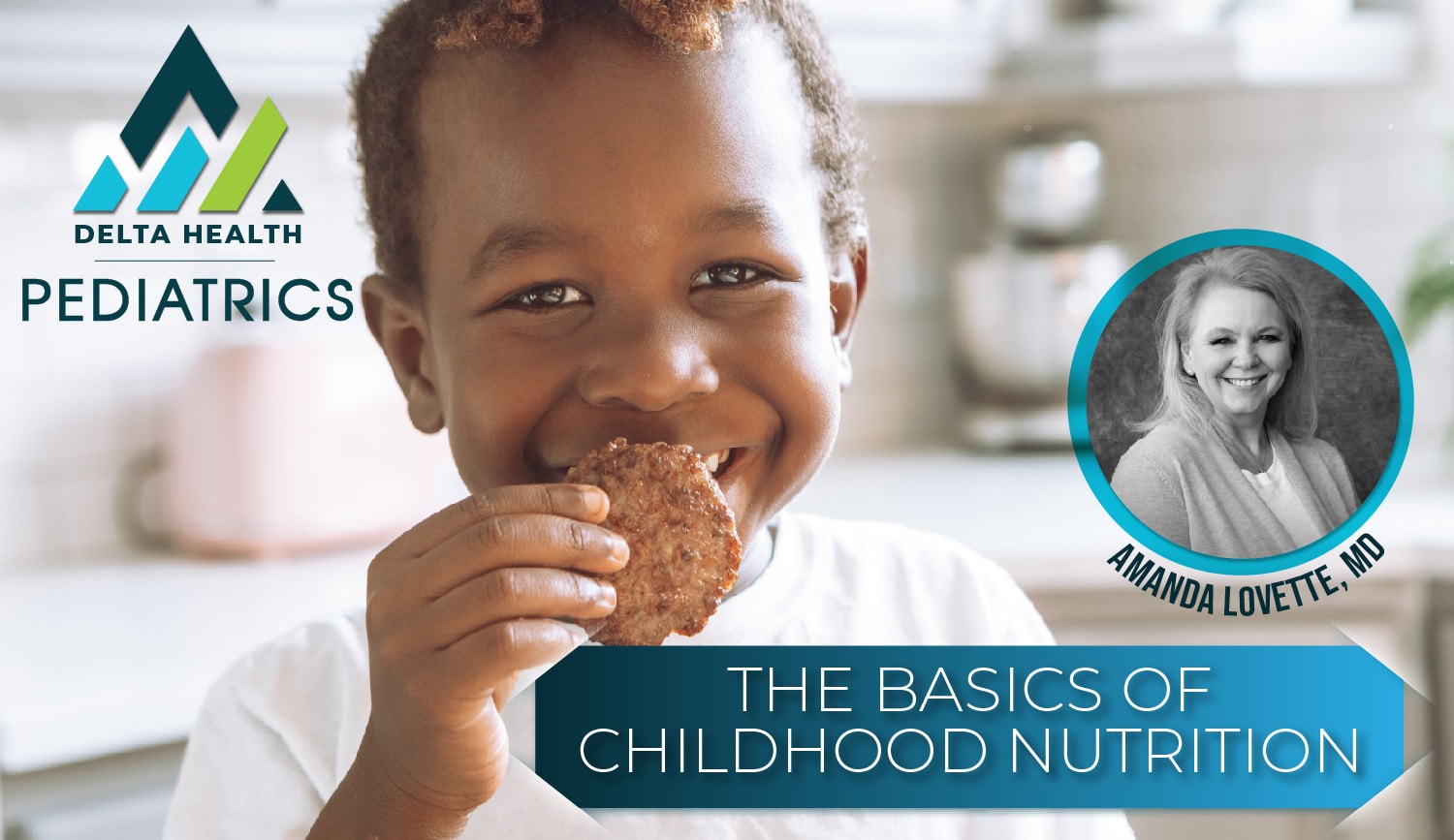By: Amanda Lovette, M.D.
Childhood nutrition is a hot topic and one I discuss frequently with my families in the office. Parents want to know the best foods to feed their child, what to do if they don’t eat or don’t want to eat what mom or dad have put on the table, alternatives to cow milk, when to know if their child is hungry or just bored, and more. We will address these topics this month.
I thought, however, I would start with the basics. What does healthy nutrition look like for your child?
Many people think they know the answer, but the truth can be tricky. Food companies are very, very good at making you think the foods they produce are healthy, full of vitamins and fiber and whole grains and will make your child so very healthy! They don’t mention the additives and the chemicals and the preservatives they place in the food that you then feed to your unsuspecting child. A diet full of nonprocessed foods is the very best gift you can give your child.
It is helpful to learn about nutrition by understanding the basics. What simple nutrients does your child need to stay healthy? I will summarize an article by WebMD about Kid Nutrition Basics for Children that discusses 5 key nutrients your child needs that will help keep their bones and teeth strong, their guts working well, their blood pumping oxygen-rich blood, and their immune systems strong.
Calcium is critical to your child’s bone and tooth health. Humans especially need this nutrient in childhood when our bones are actively growing. Dairy is a good source of calcium, but it can also be found in those leafy green veggies like kale and spinach. Starting your child’s day with a bowl of oatmeal or cold or hot whole-grain cereal made with low-fat milk and fruit is a great way to send them off to school. Or serve yogurt (not the high-sugar kind – get simple no-sugar-added yogurt and add pureed fruit or a teaspoon or two of honey), cheese, or smoothies made with milk and fresh fruit. If your child has issues with dairy, calcium-fortified nut milk or calcium-fortified juices (in small amounts) or cereals are a great way to give your child his daily calcium requirements.
Fiber is also very important. Our guts do not work well without fiber and plenty of water to wash it down. If these foods are unpalatable to your child, here are some ways to make your family like fiber-rich foods.
- A bowl of high-fiber cereal for breakfast is a great way to get fiber in your child’s diet. Look for cereals with at least 3 grams or more of fiber per serving, and sweeten the cereal with your child’s favorite fresh, canned, or frozen fruit.
- Cut up fruits and veggies your child likes and keep available for snacks. Avoid excessive juices because they have lots of sugar and very little fiber.
- Beans have lots of fiber and protein. They can be added to many meals like stews, soups, salads, scrambled eggs, salsa, and omelets.
- Prunes are a great source of constipation and will help prevent constipation.
Protein is the building block that makes up the large majority of our cells and organs. Making sure there is plenty of it in your child’s diet is critical for healthy growth and development. You can find protein in animal products like eggs, dairy, seafood and meats, nuts, some veggies, and grains.
- Fun fact – French toast made with eggs, scrambled eggs, pancakes, and omelets are usually well received by children and have lots of protein, iron, and other important nutrients. There are even some store-bought pancake mixes that have extra protein included.
- Try topping salmon or other fish fillets with teriyaki sauce or salsa which will give your child the protein and also the heart-healthy omega-3 fatty acids.
- If your older child is not allergic to nuts, try adding these to yogurt, cereals, or veggies for added protein, fiber, and healthy unsaturated fats.
Antioxidant superfoods help defend your body from harmful substances that can damage your cells, and these substances are all around us and in the food we and our families consume. Berries, almonds, citrus, carrots, spinach, tomatoes, and bell peppers are all great sources of antioxidants.
- Pack your child’s school lunch with baby carrots and tomatoes or bell pepper slices with hummus for a wonderful antioxidant meal.
- Add antioxidant-rich tomatoes or sauce to pizza, spaghetti, meatloaf, soups, and stews.
- Snack on orange slices or other citrus fruit at sports practice.
Iron is needed by the body to make healthy blood cells that can carry plenty of oxygen to the organs and tissues of the body, which helps children grow and develop normally and gives them plenty of energy. Iron can be found in green leafy vegetables, fish, lean meats, dried fruits, and iron-fortified grains. Try these ideas to get more iron in your child’s diet:
- Pair scrambled eggs with vitamin C foods like oranges to increase the absorption of iron in your child’s gut.
- Serve spinach salad with strawberries, dried cranberries, and raspberry vinaigrette dressing – most kids will love the taste.
I know that in the real world, kids eat lots of processed foods that are engineered to be hyper-tasty and which make real foods like the above suggestions taste bland in comparison. Know that the less processed food you feed your children, the more they will come to love real unprocessed food. Be patient with your children’s taste buds and never stop trying to feed them healthy foods.
To learn more, visit https://deltahealthco.org/delta-health-pediatrics/ or call 970.546.4000


